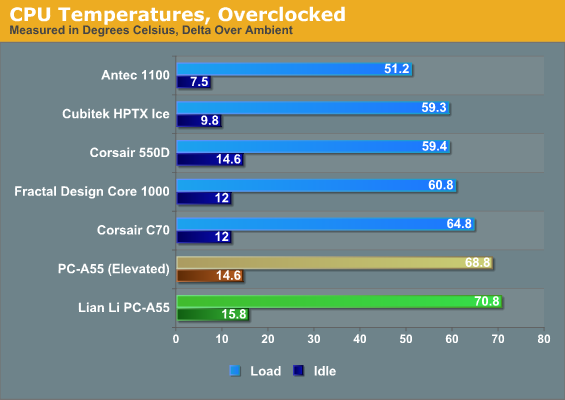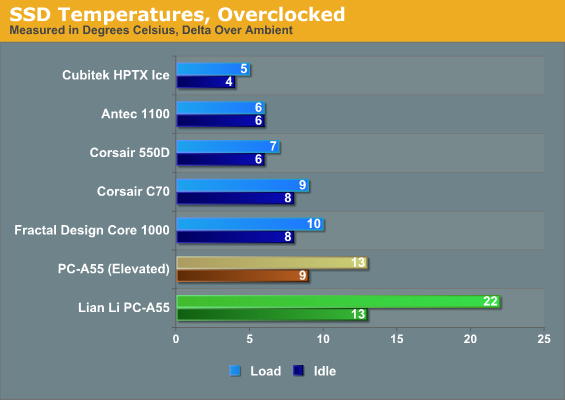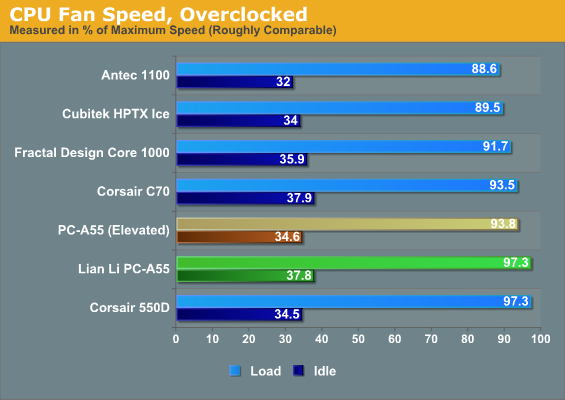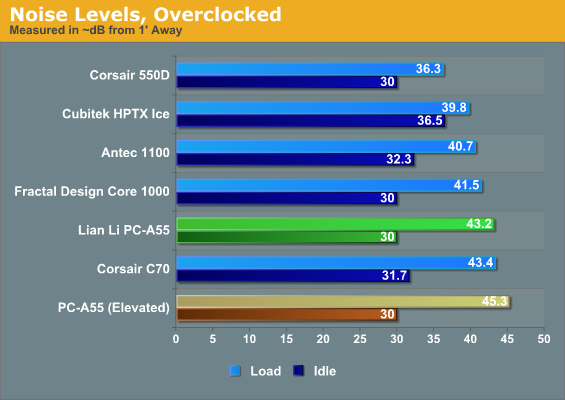Lian Li PC-A55 Case Review: Unfortunate Name Befits the Design
by Dustin Sklavos on June 16, 2012 12:30 PM EST- Posted in
- Cases/Cooling/PSUs
- mid-tower
- Lian Li
- ATX
Noise and Thermal Testing, Overclocked
Lian Li's PC-A55 is the first time I've actually been nervous about thermally testing a case. The CPU cores were already pushing the mid-to-high 80s at stock settings under load; how was this whole thing going to fare when I bumped up the clocks and pumped more voltage through the CPU and graphics card? As it turns out, it wasn't going to fare well at all, and I'm thankful we live in an era where our hardware has thermal protections in place. Ten years ago, I likely would've had to replace most of the testbed after this.



On the charts it doesn't look as bad, but keep in mind that the Intel Core i7-2700K's cores were actually hitting 95C with the case elevated, and 98C without. The GeForce GTX 560 Ti was also peaking at 95C. All of this in a room with an ambient temperature of about 24C, a temperature which isn't terribly uncomfortable or unreasonable. If the PC-A55 had a hard time dealing with a stock system, it flat out couldn't deal with any kind of overclocking. What's worse, look at how heat builds up around the SSD and imagine what would happen if a mechanical drive were used.


Our Cooler Master Hyper 212 Evo was being pushed as hard as it possibly could and the CPU thermals were still hitting the maximum spec. The normally efficient custom cooler on the ASUS GeForce GTX 560 Ti had just as hard a time, with the fan basically maxing out under load. Lian Li's design has virtually no thermal headroom. With the elevated testbed, the GPU does better, but even so it places last out of our set of cases.

The PC-A55 basically winds up being our worst-case scenario on almost all fronts. While it remains quiet at idle, under load it's very noisy and uncomfortable to listen to, due to the fact that the fans running inside are all going at full bore. As a side note, because of the aluminum shell, the top of the case was actually almost painfully hot to the touch when tested under these conditions. Putting the case on a flat surface helped thermals a bit, but also gave noise one more place to escape, causing it to run even louder.










64 Comments
View All Comments
Stuka87 - Saturday, June 16, 2012 - link
You just proved that you are not a regular here. Every new Mac/iPhone/iPad gets heavily reviewed here.This site is for "Computer Enthusiast" like you said. That means ALL COMPUTERS. Not just non-Macs. I also find it funny that you says its for Open Standards, which most things reviewed here run Windows.
I think you should just run along now.
jmhart - Saturday, June 16, 2012 - link
Wait, you're calling HIM a poser?AVP - Sunday, June 17, 2012 - link
Where do losers like this get this mentality?Voo - Sunday, June 17, 2012 - link
Ah one of the new kids on the block that want to boast, but sadly have no idea what they're talking about.Yep there really aren't any Mac users on AT, apart from several staff members.
zanon - Saturday, June 16, 2012 - link
Thank you for the thorough review Dustin. I know you dislike having to rag on and thumbs down something that people put effort into, but as potential customers we appreciate it, and Lian Li shouldn't be excused too much. While I very much appreciate companies that are willing to really experiment and push the envelope, they aren't running a charity, they're charging real money and have a duty to be professional. Basic thermal testing isn't rocket science, it's the sort of thing that any company should be doing as a continuous part of R&D, precisely to catch these issues. It's a core part of the engineering they should be doing. If you could get those numbers, they should have been able to as well long before ramping manufacturing. Someone should have said "hey wait a second, this isn't going to be that compelling, I guess we have to go back to the drawing board here."I worry that a lot of companies don't use measurement-based reality checks as much as they should be. I hear a lot of "well design is an art, not a science" type of wishy-washy statements (the audio industry seems to be the worst), but ultimately science is definitely a part. They should be as wild as they like in the concept and prototype stages, but everything should go through a careful measurement filter before further work. Hopefully they can do better next time around, they certainly have the engineering chops to produce excellent work. Everyone produces duds once in a while, if it's not a pattern then they can bounce right back with a useful lesson learned.
Thanks again for the balanced review.
Olaf van der Spek - Saturday, June 16, 2012 - link
I'd optimize for depth instead of height. mATX, ODD above board, PSU and HDDs below. Straight front to back airflow. 2x 140 or 2x 180 in front should be enough. Depth of 350mm should be achievable.Dustin Sklavos - Saturday, June 16, 2012 - link
Actually a single 180mm can more or less nail it:http://www.anandtech.com/show/4533/silverstone-tem...
Olaf van der Spek - Saturday, June 16, 2012 - link
The TJ08-E is nice but a bit too cramped and a bit too long.Iketh - Saturday, June 16, 2012 - link
How is this cramped??http://www.overclock.net/gallery/image/view/album/...
Olaf van der Spek - Saturday, June 16, 2012 - link
You forgot to install the HDD cage...